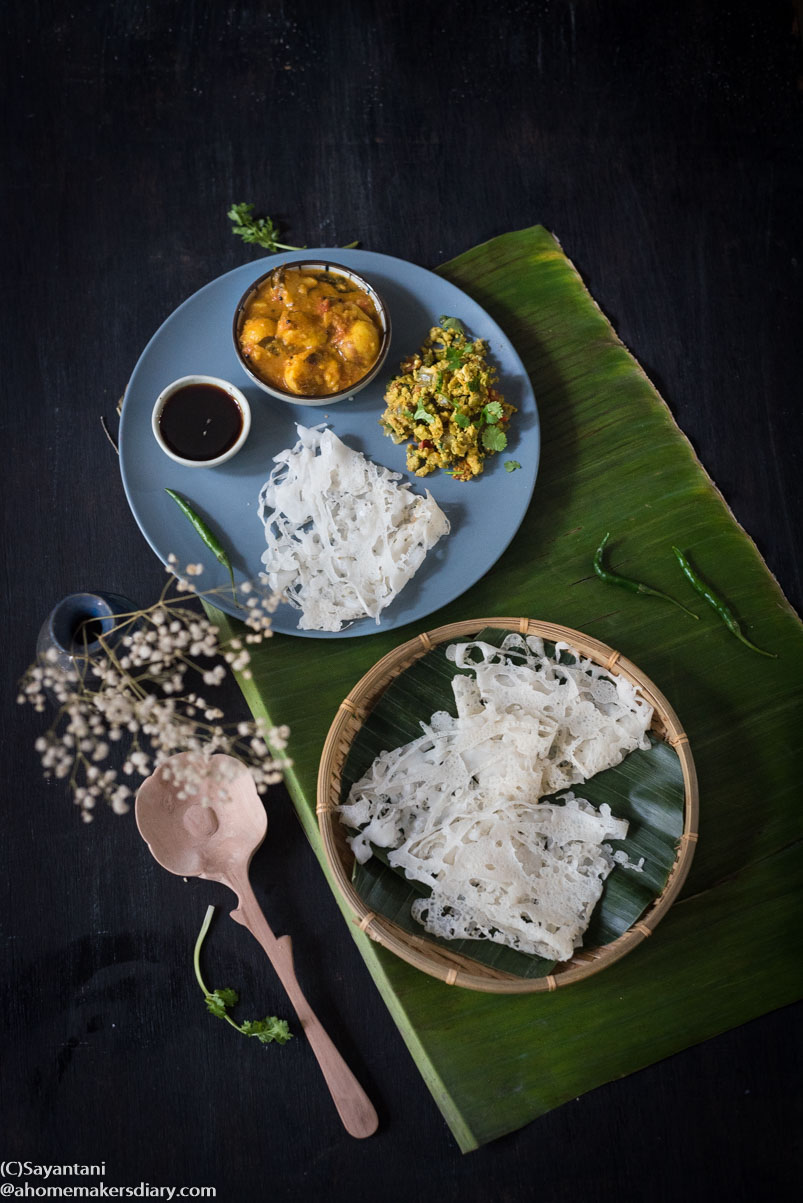Chit Ruti or Chita pitha
6:00 PM 
What is your
traditional breakfast is a question that I often face. Especially from the
foreign guests during our cuisine walks, all curious about Bengali food after a
leisurely discussion and walk through the fascinating Gariahaat market.
The first time I heard this question, I got a little startled and could not reply quickly. Honestly, the breakfast that I have most days is toast and egg which in no way is a traditional breakfast. It rather is a hangover from the 200 years of the British Raj and Bengal being its capital for about 139 years (1772-1911). The other popular breakfast items most Bengalis would drool over and get nostalgic about be it luchi, kochuri or Radhaballavi are occasional/ festive breakfasts not to be had daily.
Read more by clicking on the heading...
Bengal from time immemorial had been a rice-centric economy which keeping in mind its hot and humid weather is perfect to consume as well. It’s not only food, but Bengal’s relationship with rice is a very emotional one. Bengali traditions, festivals, and all its ceremonies have a consecrated use of rice. From snacks to celebratory meals, from everyday staple to a special therapeutic meal ('pothyo' পথ্য) Rice is used in many Avatars, in many ingenious ways.
In
earlier days and in rural Bengal Rice still is consumed four times a day,
albeit in different forms. Before going to work people in rural areas prefer to consume a big bowl of rice. Hot steaming rice or broken rice
porridge (Jau bhat) in winter and panta or overnight soaked rice in summer.
Apart from that chire (beaten rice/poha), muri (puffed rice/ murmura), chalbhaja (rice grains fried in a kadhai) and khoi
(Popped rice/lai) feature in different combinations like dudh muri (milk with
puffed rice), chire doi aam (beaten rice with yogurt and mangoes) or Khoier moa
(popped rice laddu with jaggery) throughout the day, sometimes for breakfasts
sometimes as a snack.
But
with the new rice crop arriving home, winter has always been a special time in
Bengali households. Just after Deepawali as winter starts to settle down,
various traditional recipes mainly under the broad category of ‘pitha’ or rice
cake start to appear on our plate. This chit ruti or chita pitha is one such.
Very similar to Malaysian “roti Jala’ or net bread these lacy ‘chita rutis’ are
a perfect canvas for any spicy side dish.
Chit’ or chita’ comes from the Bengali word ‘chitano’ or ‘chetano’ meaning ‘to sprinkle’, which describes the process of making this dish. Using one’s fingers a thin rice batter is sprinkled on a hot tawa/pan to make this slightly crisp pancake with a lacy delicate appearance. Very popular in Bangladesh or East Bengal as a breakfast item and is mostly paired with dimer jhuri (spicy scrambled eggs), leftover curry, or an indigenous cheese called ‘ponir’.
While growing up this was not part of our regular pithe repertoire. Maa learned it at quite a later stage from one of her classmates in Santiniketan and made it a couple of times. Much later while looking for gluten-free breakfast options I rediscovered it again. Like most pithe recipes this also calls for only a couple of pantry staples but on a chilly winter morning this humble plate of breakfast will cocoon you in a blanket of warmth that you would never want to leave.
And if cooking comforts you then on a leisurely unhurried day, preparing this will feel therapeutic too. The cold runny batter on the fingers, the sizzle of the pan, the aroma of new rice wafting from it and filling the entire house would impart a peculiar sense of Déjà vu. Like an inherited memory without any associated sensory experience, something that we have had and lost yet which never fails to ground us with gratitude
Chit
Ruti
(Makes
12 rotis)
Ingredients:
Atop
or Sundried rice: 1 cup
Salt:
as per taste
Water
as required
Method:
Wash
and soak the rice overnight.
In
the morning grind it to a smooth paste. Start adding room-temperature water little by
little. The idea is to create a thin batter that barely will coat the back of a
spoon. Please watch the video for clarification. Add salt as per taste.
Check the following video for making chit ruti.
Place
an iron Kadhai or pan on the stove. Wait till it is smoking hot. Grease the
surface with little white oil and Put the flame on low. Using your fingers pick
up some batter and start gently splashing on the surface. I prefer to first make
a crisscross pattern around the edges and then sprinkle more batter within the
gaps to get a proper lacy texture.
By
the time you finish sprinkling the batter the pitha will be cooked. Using a
spatula fold it in quarters and serve hot with dimer jhuri.
Dimer
jhuri
Ingredients:
Eggs:
4 (I used country chicken eggs)
Onion:
2 medium
Tomato:
1 big
Garlic:
3-4 cloves
Coriander
leaves: a small bunch
Green
chillies: 3-4 or as per taste
Salt
Turmeric
Mustard
oil: 1 tbsp
Method:
Break
and whip the eggs well with a little salt.
Finely chop onion, garlic, tomatoes, chilies, and coriander. Don’t mix, keep everything separate.
Heat
a pan and add the oil. On medium heat first, add the garlic and chilies, and saute
for a few seconds. Then add the onion and sprinkle some salt. After a minute of
cooking add the chopped tomato, little salt, turmeric, and sauté well for 2
minutes.
Now
put the flame on low and pour in the egg. Stir and cook it for the next 4-5
minutes till the egg is set around the vegetables.
Sprinkle
the coriander and serve hot with Chita pitha.





















0 comments